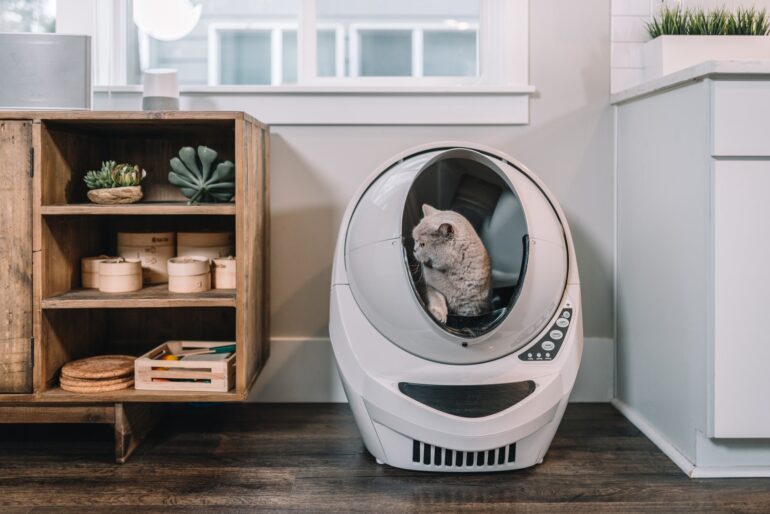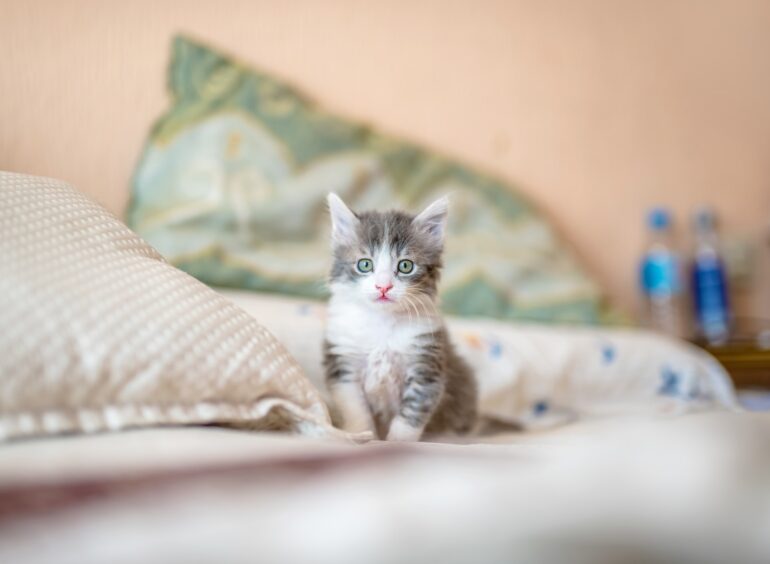Litter boxes and young children are usually not a good mix. A cat litter box can contain parasites, bacteria, worms and lead to infections. Therefore, it is not a safe place for a child to hang out or discover without supervision.
Like cats, children are curious. If a young child sees their cat using a robotic-looking machine, it wouldn’t be unusual for them to try to follow in their footsteps (or in this case paw prints). So if your household includes children and cats, you might be wondering if an automatic litter box is a safe product to have with a little one running.
As parents of human babies and fur babies, we understand that you want the whole house to be happy and safe. So, let’s learn how safe self-cleaning litter boxes are and explore the safety features these units have in place to keep them out of harm’s way.
How safe are automatic litter boxes to start with?
In short, self-cleaning litter boxes are generally safe for young children. Plus, since these units self-collect regularly, they pose less of a risk to your child’s health than standard litter boxes which must be picked up manually and can leave litter in the litter box at any time.
Automatic litter boxes are designed in such a way as to keep our cats unharmed which also prevents our children from getting hurt. Still, not all automatic litter boxes are created equal in this regard, and some models are certainly safer than others. Here’s what to look for when choosing your high-tech litter box.
A slow and gentle cleaning cycle
There are different cleaning systems that an automatic litter box can use. The traditional style is a rotary mechanism. It is a terrestrial globe on an axis that rotates to sift the litter and remove clumps. Although this gives a fairly effective cleaning, it is not the safest method as the movement is faster than other systems.
In fact, many self-cleaning litter box manufacturers these days are taking a different approach due to the safety issues that have arisen with the spinner mechanism over the past few years.
These safety concerns led to the redesign of the horizontal sweep method, which is used in various models today, such as the AutoEgg or ScoopFree by PetSafe. With this system, a rake moves in slow motion through a zig-zag litter box to capture and dispose of cat waste. Overall, this method is much gentler and safer, but just as effective.
The cleaning system is an important safety consideration. Just as your cat can fit into the box while a cleaning cycle is in progress, your child might also put their hand inside halfway through cleaning (sounds like a recipe for disaster). A mechanism that cleans the litter box slowly and gently will not cause any harm to your cat or child if it enters halfway through cleaning.
Safety sensors

Unfortunately, some of the first automatic litter boxes on the market created valid safety concerns without a proper sensory system to detect movement during cleanings.
There have even been reports of injuries to cats caused by the units, especially cats trapped in the litter box. This happened when the cat entered during a cleaning cycle, and there was no safety device to stop the movement of the cycle and a tail or paw got stuck in the mechanism.
Fortunately, in 2022, the safety of self-cleaning litter boxes has improved significantly. These days, almost all automatic litter boxes are equipped with a cat sticking prevention sensor. This means that if your cat enters the box halfway through cleaning, the sensor will detect your cat’s presence and pause the cycle. Then it will not start again until it feels that your cat has left the box.
In theory, this sensor should also detect your child who puts his hand in the box or tries to crawl inside. While this gives parents peace of mind, knowing the accuracy of your litter box sensors is critical, as again, not all models are the same.
Shorter cleaning cycles
Another way to reduce the risk of injury or illness for your child is to opt for an automatic litter box with a short cleaning cycle. Some alternative machines, such as disposable systems, can take up to 30 minutes to clean. In contrast, horizontal raking systems typically only take five to ten minutes. The shorter the cleaning cycle, the less time your child has to have a bowel movement.
Closed design

Most automatic litter boxes have a hood to keep the litter box covered. This limits your child’s access to the box and may reduce their interest in it. The closed style also prevents litter from escaping, preventing your child from picking up dirty and bacteria-contaminated litter particles, or worse, ingesting them!
Some units also have a tracking step at the entrance to catch the litter from your cat’s paws and reduce waste tracking more.
Keep your child away from cat poop
The biggest concern with children and kitty litter is the possibility that they will pick up the droppings. If your child touches cat feces, it can be very harmful to their health. Cat feces are full of contagious poisonous bacteria that can cause nasty infections in humans, especially young children with weaker immune systems.
Automatic litter boxes remove waste very quickly, usually 5 minutes after use. For this reason, they are certainly safer for households with children than traditional litter boxes where cat droppings can sit for hours. However, even though there is a much lower chance of your child getting into the box and touching the cat poop, it is still possible.
If you notice your child following the cat to the litter box and dragging around when using it, you need to take preventative measures to make sure your child does not receive the waste until the cleaning cycle begins.
In this case, we recommend that you keep it in a space where your child cannot access it. While you can put the box in a closed room with a cat flap, we find the most practical and practical solution is to use a baby gate. These are easy to set up and most cats can squeeze into spaces or jump without a problem.
Conclusion

The advanced technology of today’s automatic litter boxes makes them safe to use around children. In addition, the higher hygiene standards of the self-cleaning versions are generally a ideal litter box choice for homes with kittens and children.
Even so, that doesn’t mean that every automatic litter box will be completely reliable. You should always be very careful and take into account the use of any electronic product near small children.
